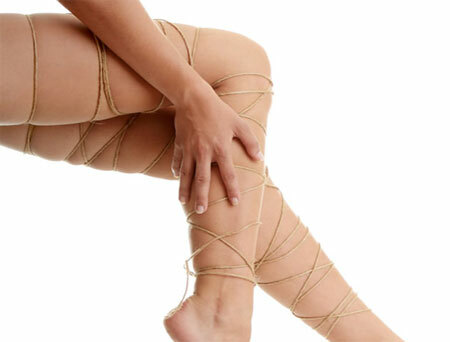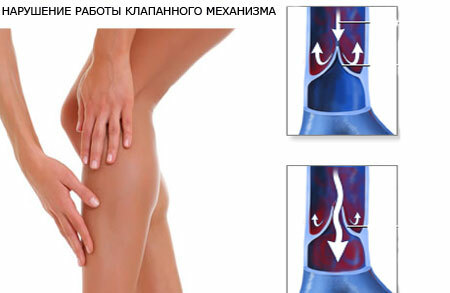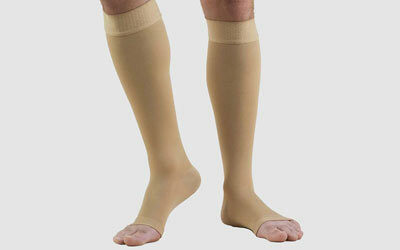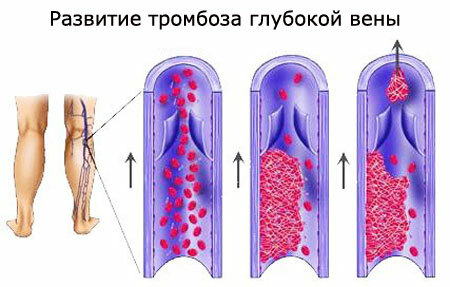With the problem of venous insufficiency of the lower limbs, a person faces almost immediately when he starts walking. Up to a certain time compensatory mechanisms work that do not allow this process to progress.
Under the influence of contributing factors to a certain age, many people face this problem. Let's see why this happens and what to do about it.
Contents of
- 1 CVI - What is it?
- 2 Causes of
- 3 Symptoms of venous insufficiency of lower extremities
- 4 Treatment of venous insufficiency
- 4.1 Prevention
CVI - What is it?

Chronic venous insufficiency of the lower extremities( CVI) is a combination of certain symptoms that are caused by poor outflow from the veins of the lower extremities due to a violation of their hemodynamics.
There are two main factors involved in the pathogenesis of the development of the disease.
- Firstly, it is a decrease in the diameter of the vessel and, as a consequence, a decrease in its transmissive capacity.
- Secondly, there is a violation of the mechanism, which provides an outflow of venous blood from the veins of the lower extremities.
How it looks in practice: in a normal person, the outflow of blood from the veins of the lower extremities occurs through a system of deep and superficial veins to the heart. Such a flow of blood against the action of gravity becomes possible due to the valve mechanism in the veins that prevent blood from flowing in the opposite direction. A certain role is played by the contraction of the muscles of the thigh and lower leg, as well as the state of the vascular wall.
If there is a malfunction in the work of this established outflow system, the venous blood instead of rising from the veins of the legs to the heart, lingers, causes vascular overflow and the appearance of various unpleasant symptoms. So, gradually microcirculation processes are being disrupted, edema and trophic disorders develop.
Important! The highest venous pressure in the lower third of the shin, that's why the first problems with venous outflow begin here.
In fact, CVI is not a separate diagnosis. This is a complex of symptoms associated with the violation of the veins, which can occur both with congenital and with acquired pathology.
Causes of

Causes of venous insufficiency of the lower extremities:
- decrease in the diameter of the venous bed;
- violation of the valve mechanism, in the case of problems with which the return of blood to the vein occurs.
The most common cause of CVI is varicose and post-thrombophlebitic syndrome. In rare cases, the problem is caused by congenital abnormalities of the vessels( fistulas, fistulas) and traumatic injuries.
In addition to these key reasons, the contributing factors to the risk of this pathology are:
- Hereditary predisposition to the development of weakness of the vascular wall.
- Pregnancy. In addition to hormonal adjustment, during this period, the load on the vessels increases, which leads to the development of varicose veins and the appearance of chronic venous insufficiency in every third woman.
- Hormonal disorders and endocrine pathology.
- Excessive physical activity. Excess weight and metabolic disorders.
- Atherosclerosis.
- Congenital malformations of veins.
- Alcohol and smoking, which reduce the tone and elasticity of the walls of blood vessels.
- Hormonal contraceptives, etc.
Symptoms of venous insufficiency of the lower extremities

Three stages are distinguished in the clinical course, first of all it is necessary for choosing the appropriate therapy - symptoms and treatment of venous insufficiency of the lower limbs depend on the stage of the disease and are determined:
1. The compensation stage. At this stage, the symptoms of venous insufficiency of the lower limbs remind of themselves only cosmetic signs: there are vascular "stars", varicose veins on the legs are visible, etc.
Some patients report increased fatigue in the legs and the appearance of edema in the evenings, others do not pay attention to it. To learn about the diagnosis and assess the degree at this stage is possible only with the help of special studies.
2. The stage of subcompensation. At this stage, the patient develops trophic disorders that can be treated. The patient's standard complaints at this stage are:
- pain and fast fatigue of the legs;
- cramps and tingling in the legs;
- itching of the skin;
- trophic disorders( ulcer, eczema).
Even at this stage, patients most often turn to a specialist, primarily because of cosmetic defects( ulcer, varicose veins).
3. The stage of decompensation. There are irreversible trophic disorders. The patient is worried about pronounced swelling( elephantiasis), severe ulcers develop that are not amenable to treatment, skin color changes on the legs( purple-black), pains and problems with walking.
Important! In addition to the stage, when diagnosing CVI, the main disease that caused the development of the symptom complex, as well as the form of CVI: edematous, painful, varicose, ulcerative or mixed. Therefore the diagnosis will sound approximately so: the Varicose illness. CVI II stage, edematous-painful form.
Treatment of venous insufficiency

Treatment of venous insufficiency of the lower limbs depends on its degree, shape and the presence of concomitant complications. The problem is solved conservatively and surgically.
Conservative therapy consists of:
- taking medications that improve the tone of the vascular wall( phlebotonics) and the rheological properties of the blood;
- elimination of risk factors( weight loss, normalization of diet and physical activity, pregnancy planning);
- physiotherapy;
- prophylaxis of the progression of the pathological process( wearing compression linen, bandaging, charging).
Operative treatment is aimed at eliminating directly varicose veins. Sclerotherapy is used for this purpose( sclerosant is injected subcutaneously, which causes clumping of the vessel walls), as well as various operations for resection of superficial veins( according to Troyanov-Trendelenburg, Linton and others).
Complications of
Most patients mistakenly believe that ugly enlarged veins are the main complication of the disease, but the problem is much more serious.
The complication of CVI can become:
- Trophic ulcers. These are non-healing skin defects that appear in advanced stages. They are not amenable to treatment and they give painful pain to patients.
- Thrombophlebitis - inflammation of the vein wall with the formation of thrombi( blood clots).
- Thromboembolism of the pulmonary artery. Closure of the thrombus and its migration through the blood stream can cause blockage of one of the branches of the pulmonary artery and lead to death.
- Eczema and erysipelas.
Prevention
Prophylaxis is divided into two groups. The first includes measures aimed at preventing the development of the pathological process:
- weight loss;
- physical activity;
- rest with raised legs;
- wearing compression linen if necessary;
- quit smoking, etc.
The second group includes activities that inhibit the progression of CVI and do not give rise to severe complications:
- wearing compressive underwear of a certain compression class( determined by a specialist);
- course passage of physiotherapy( balneotherapy, massage, etc.);
- pregnancy planning in the presence of varicose veins;
- exercise therapy;
- regular monitoring of the state of veins( ultrasound and other research methods).
CVI can bring a lot of trouble if you do not take care of its prevention. A competent regimen, weight loss, vascular monitoring and other measures will help prevent the development of serious complications.



